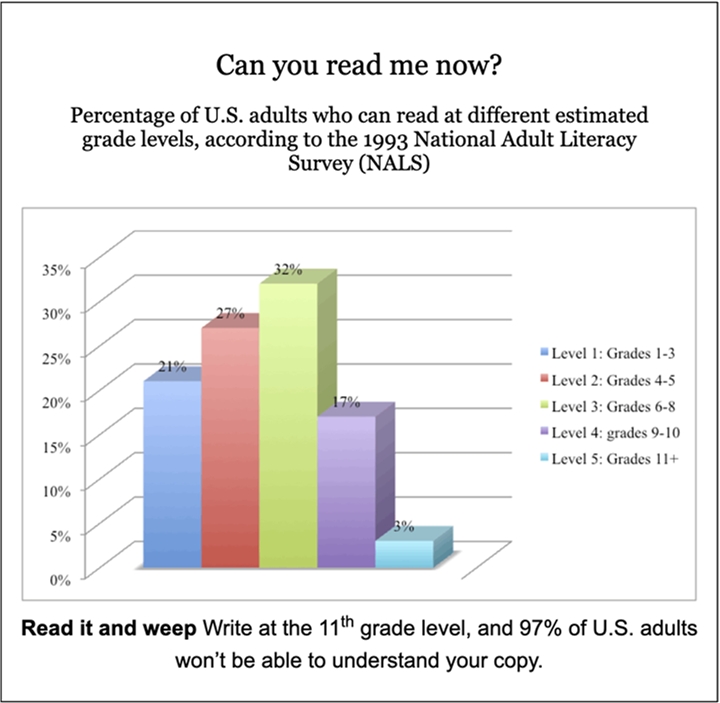27% of Americans can’t write simple messages or letters
What reading grade level should you hit on the Flesch-Kincaid, Gunning Fog or other readability indexes?

That depends.
Average? 8th grade.
The average U.S. adult reading level is 8th grade.
The average U.S. adult reading level is 8th grade, according to most estimates. For a general audience, then, that’s a good average.
Why so low?
Some 85% of U.S. adults aged 25 and older had completed at least high school in 2003, according to the U.S. Census Bureau. And 27% had college degrees. Both of those numbers represent all-time highs.
But still, Americans don’t read as well as you might think.
Three literacy scales.
In 1993, the U.S. Department of Education conducted the first National Adult Literacy Survey, the most comprehensive, statistically reliable source on literacy in the United States. It studied 26,000 U.S. adults, representing 191 million people, on three literacy scales:
The study looks at:
- Prose literacy — the ability to search, comprehend and use information from linear copy, like articles.
- Document literacy — the ability to search, comprehend and use information from nonlinear materials, like maps.
- Quantitative literacy — the ability to identify and perform computations using numbers from printed material.
The results? Nearly half of the Americans surveyed couldn’t read well enough to find a single piece of information in a short publication or make low-level inferences based on what they’d read, according to “Adult Literacy in America” (PDF), a report based on that study.
21% nonliterate
Level: 1. Grades: 1-3.
Number/Percentage of Americans over 16: 40 to 44 million; 21%
These folks aren’t literate enough to perform tasks necessary for functioning in everyday life, according to The National Institute for Literacy’s “The State of Literacy in America: Estimates at the Local, State and National Levels” (PDF).
These folks aren’t literate enough to perform tasks necessary for functioning in everyday life.
Most of them can sign their names, identify a country in a short article, locate one piece of information in a sports article, locate the expiration date on a driver’s license or total a bank deposit entry.
But most cannot figure out eligibility from a table of employee benefits, locate an intersection on a street map, find two pieces of information in a sports article, identify and enter background information on a Social Security card application or calculate total costs of purchase from an order form.

27% below basic
Level: 2. Grades: 4-5.
Number/Percentage of Americans over 16: 54 million; 27%
Most can’t write simple messages or letters.
Most in this group (and Level 1) can’t write simple messages or letters; locate a piece of information when there are several plausible options; or compare and contrast easily identifiable information.
Most, for instance, can’t read a sports article and identify the age at which the swimmer began to swim competitively.
32% basic
Level: 3. Grades 6-8.
Number/Percentage of Americans over 16: 61 million; 32%
Most can’t write a brief letter explaining an error on a credit card bill.
Most in this group (and Levels 1-2) can’t write a brief letter explaining an error on a credit card bill, read a magazine article about a woman and provide two facts that support an inference about her or figure out the price per ounce of peanut butter in a 20-ounce jar costing $1.99.
17% intermediate
Level: 4. Grades 9-10.
Number/Percentage of Americans over 16: 29 to 33 million; 17%
Most in this group can’t contrast two opposing views in a newspaper feature about fuel-efficient cars.
Most in this group (and Levels 1-3) can’t contrast two opposing views in a newspaper feature about fuel-efficient cars, identify a theme or organizing principle in a newspaper column or understand a simplified written explanation of the procedures used by attorneys and judges in selecting juries.
3.5% proficient
Level: 5. Grades 11 and up.
Number/Percentage of Americans over 16: 6 to 8 million; 3.5%
The only group with literacy skills adequate for traditional college study
This is the only group that demonstrated literacy skills adequate for traditional college study — a level that 30% of all U.S. high school students reached in 1940, according to The Odysseus Group’s John Taylor Gatto.
Are you smart enough to write for a 5th grader?
___
Sources: Michael D. Aldridge, “Writing and Designing Readable Patient Education Materials,” Nephrology Nursing Journal, vol. 31, no. 4, July/August 2004, p. 373-377
Kenneth Brownson, “Literacy: A Problem that Managers Must Handle,” Hospital Materiel Management Quarterly, vol. 20, no. 1, August 1998, p. 37-47
William H. Dubay, “The Basics of Plain Language,” Impact Information: Plain Language Services, 2005
John Taylor Gatto, “The National Adult Literacy Survey,” The Odysseus Group
Douglas Mueller, “The Fog Index,” Folio:
Robert Longley, “U.S. High School Graduation Rate Hits All-time High,” About.com, July 5, 2004
TJ Larkin & Sandar Larkin, “Most Adults Can’t Understand Our Health Communication,” Larkin Page, No. 54, January 2007
TJ Larkin & Sandar Larkin, “Patients Don’t Remember Doctors’ Instructions,” Larkin Page, No. 78, January 2008
“The State of Literacy in America: Estimates at the Local, State and National Levels” (PDF), National Institute for Literacy, 1998
“What do low literacy and limited English proficiency mean?” U.S. Department of Transportation Federal Highway Administration, FHWA.dot.gov

Leave a Reply